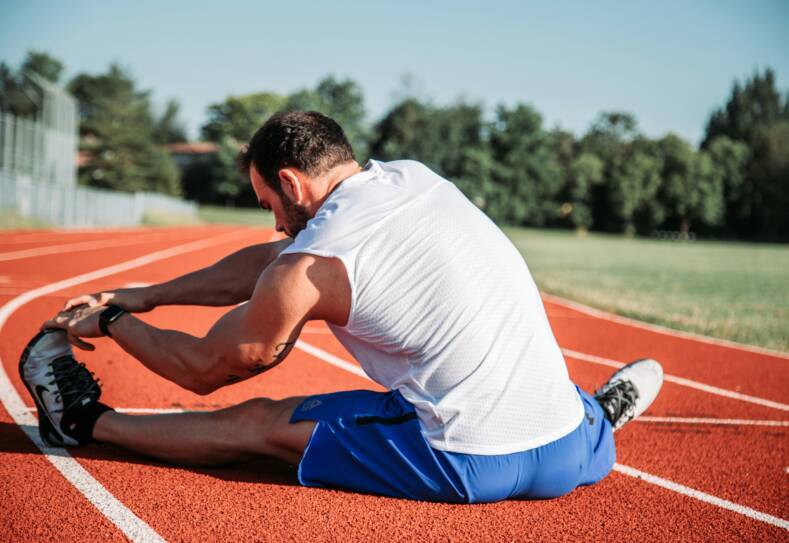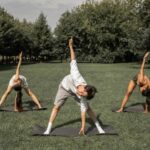In the realm of physical fitness, stretching is as much a staple as the workout routine itself. It is well understood that incorporating stretching into an exercise regimen offers numerous benefits, including increased flexibility and decreased risk of injury. However, the debate on whether to stretch before or after a workout has persisted among fitness enthusiasts and health experts. Research into the topic has shifted perspectives on conventional wisdom, leading to a more nuanced understanding of stretching’s role in exercise.
Stretching before a workout traditionally involved static stretches meant to limber up the muscles in preparation for physical activity. However, more recent insights suggest that this form of stretching, when done before high-intensity exercise, may not be as beneficial as once thought, potentially even leading to diminished performance. Instead, a dynamic warm-up with movement similar to the planned activity is now favored to prepare the body for exercise.
Post-workout stretching tells a different story. After exercise, the muscles are warm and more pliable, making it an opportune time to engage in static stretching. This can help in muscle recovery, reduce soreness, and contribute to overall flexibility. Extending the stretch for slightly longer periods after a workout complements the body’s natural process of cooling down and returning to a state of rest, aiding in the recovery phase and ensuring the body is less prone to tension or strain.
The Importance of Stretching
Stretching is an integral part of any fitness regimen, directly impacting injury prevention and the enhancement of range of motion and flexibility.
Benefits for Injury Prevention
Injury prevention is significantly influenced by regular stretching. By preparing the muscles and joints for activity, individuals can reduce the likelihood of sports-related injuries. Stretching contributes to overall muscular health by improving blood flow and decreasing the tension in muscle groups. This preparatory action assists in minimizing the chances of tears or strains during intense physical activity.
Enhancing Range of Motion and Flexibility
Stretching has a beneficial effect on a person’s range of motion and flexibility. Consistently stretching helps maintain and improve the flexibility of joints, ensuring that they can move through their full span of movement efficiently. This is paramount for tasks requiring complex movements, and it can enhance performance by allowing muscles to work effectively. Flexibility gained from stretching can also facilitate better posture and alleviate muscle stiffness.
Different Types of Stretching
Stretching can be broadly categorized into dynamic and static forms, with each playing a unique role in preparing for and recovering from workouts. Active movements are often incorporated within these stretching techniques to enhance performance and flexibility.
Dynamic Stretching Explained
Dynamic stretching involves moving parts of the body and gradually increasing reach, speed of movement, or both. This type of stretch prepares the body for physical activity by warming up the muscles, improving range of motion, and enhancing muscular performance. Examples of dynamic stretches include shoulder rolls and walking lunges. One should perform these movements in a controlled manner to minimize the risk of injury.
Understanding Static Stretching
Static stretching is performed by extending a muscle to its furthest point and then holding that position for a period of time, usually between 15 to 60 seconds. It is best utilized after exercising as it helps facilitate muscle recovery and increases flexibility. Common static stretches include the quad stretch, hamstring stretch, and calf stretch. These types of stretches allow the muscles to relax and may help to reduce post-exercise soreness.
Active Movements and Stretches
Active stretches are similar to static stretches, but they involve actively contracting the muscle during the stretch. They rely on the strength of the opposing muscle group to hold the stretch and are great for improving muscular endurance. These stretches engage more muscle groups and can improve active flexibility. They often include movements like leg lifts and arm swings, which are particularly beneficial for athletes who require a high degree of control over their movements during their sports or activities.
Pre-Workout Stretching
Effective pre-workout stretching can enhance performance and reduce the risk of injury by warming up the muscles and increasing blood flow. It sets the stage for a safer and potentially more effective workout session.
Warm-Up Techniques
A proper warm-up should progressively elevate the heart rate and prepare the body for physical activity. Dynamic stretches, which involve moving parts of the body gradually through their range of motion, are essential. Examples include:
- Leg swings to loosen the hips
- Arm circles to engage the shoulders
- Walking lunges for leg and hip activation
These movements increase heart rate and blood flow, making them effective warm-up techniques that prepare the muscles and joints for the workout ahead.
Targeted Stretches for Muscle Preparation
When focusing on pre-workout stretches, ensuring that the muscles are prepared for the specific types of movements they will perform is crucial. Here’s a list of targeted stretches:
- Shoulder rolls: to loosen the upper body before exercises like overhead presses
- Hip flexor stretch: engaging in lunges with a gentle twist to prepare for squats
- Calf raises: to prevent muscle soreness in the lower legs, particularly before running or jumping activities
Each stretch should last for approximately 30 seconds to optimize muscle elasticity without causing fatigue before the actual workout begins.
Post-Workout Stretching
After exercise, engaging in post-workout stretching can play a crucial role in aiding muscle recovery and reducing soreness. This section focuses on how stretching can help cool the body down and assist with muscle recovery, as well as its effects on delayed-onset muscle soreness (DOMS).
Cooling Down and Muscle Recovery
Post-workout stretching assists in gradually lowering the heart rate and is an essential part of the cool-down process. It allows the body to transition to a resting or near-resting state in a controlled manner. Effective static stretches, involving extending a muscle group to its full length and holding the position for approximately 30 to 60 seconds, can aid muscle recovery by:
- Enhancing circulation: This improved blood flow may help in transporting nutrients to the muscles, which can be beneficial for repair and growth.
- Promoting flexibility: Regularly practicing static stretches post-workout can increase joint flexibility and range of motion.
Reducing Delayed-Onset Muscle Soreness (DOMS)
Delayed-onset muscle soreness, commonly known as DOMS, refers to the pain and stiffness felt in muscles several hours to days after unaccustomed or strenuous exercise. Post-workout stretching can help alleviate the intensity of DOMS by:
- Relieving tension: Stretching tired muscles can help reduce the muscle tightness associated with DOMS.
- Increasing mobility: Regular post-exercise stretching can improve muscle recovery and potentially lessen the impact of DOMS on future workouts.
Stretching and Body Mechanics
Stretching is integral to maintaining proper body mechanics, which include alignment of posture and enhancement of athletic performance through optimized muscle function. Here’s how stretching plays a role in each aspect.
Aligning Posture through Stretching
Proper stretching techniques are vital for aligning one’s posture. They reduce muscle tension which, if left unaddressed, can lead to misalignments in the body structure. For instance, pectoral stretches can remedy the forward shoulder roll caused by prolonged sitting. Similarly, hip flexor stretches are crucial for individuals who spend much of their day seated, helping to correct anterior pelvic tilt.
Improving Athletic Performance
Stretching has a significant impact on athletic performance. While pre-workout static stretching might impair performance by reducing muscle strength and explosiveness, incorporating dynamic stretches can prepare the body for activity by increasing blood flow and enhancing muscular coordination. Post-exercise, stretching helps in muscle recovery and maintainance of muscle strength. It is essential for athletes to follow appropriate stretching routines to ensure peak performance and minimize the risk of injury.
Specific Stretches for Different Muscle Groups
Before diving into specific stretches, it’s important to recognize that targeting major muscle groups effectively can enhance flexibility and reduce the risk of injury. Different stretches focus on various muscle groups such as the shoulders, back, hamstrings, and hips.
Upper Body Stretches for Shoulders and Back
- Shoulder Stretch
- To stretch the shoulders, one can perform a cross-body shoulder stretch by bringing one arm across the chest at shoulder height. The opposite hand should apply gentle pressure to the arm being stretched, holding for at least 30 seconds without bouncing.
- Upper Back Stretch
- The cat-cow stretch is beneficial for the upper back. Begin on hands and knees, arch the back upward, tucking the chin to the chest for the cat position. Then, reverse the curve by lifting the head and tailbone up, allowing the stomach to sink towards the floor, for the cow position. Transition smoothly between these positions for 30 seconds.
Lower Body Stretches for Legs and Hips
- Hamstrings Stretch
- For the hamstrings, a seated forward bend is effective. Sit with legs extended, hinge at the hips to lean forward, reaching towards the toes. Hold the position for 30 seconds to feel a stretch through the back of the thighs.
- Hip Stretch
- The pigeon pose targets the hips. From a forward lunge position, drop the back knee to the floor and rest the outer thigh of the front leg on the ground, squaring the hips forward. The stretch can be deepened by leaning forward over the front leg, holding for 30 seconds.
Incorporating Stretching into Your Exercise Routine
Incorporating stretching into an exercise routine promotes flexibility and can reduce the risk of injury. A structured approach ensures that stretching complements the workout effectively, enhancing performance and recovery.
Creating a Balanced Stretching Schedule
To create a balanced stretching schedule, it’s essential to mix dynamic stretches into warm-up routines and static stretches into cool-down phases. Dynamic stretching involves moving parts of the body and gradually increasing reach, speed of movement, or both. This type of stretching is ideal before engaging in physical activity as it helps to prepare the body for the stress of exercise.
On the other hand, static stretches are beneficial post-workout. During a static stretch, a muscle is elongated to the point of tension and held for a period. This helps muscles to recover and can aid in reducing post-exercise soreness.
Here’s a brief outline for a balanced stretching routine:
- Warm-Up: 5-10 minutes of light cardio followed by dynamic stretching.
- Post-Workout: Cool down with 5-10 minutes of low-intensity cardio or walking, then perform static stretching.
Guidelines for Frequency and Duration
The American College of Sports Medicine (ACSM) provides general guidelines for exercise prescriptions, which also apply to stretching. They suggest that adults should engage in flexibility exercises at least two to three days per week. However, stretching activities can be performed every day to achieve greater gains in flexibility.
Each stretch should ideally be held for 15 to 60 seconds and repeated two to four times, accumulating 60 seconds per stretch. This frequency and duration are suitable for most individuals, including older adults. It is always crucial to consult with a healthcare provider before starting any new workout or stretching routine, particularly for those with health concerns or conditions.
| Muscle Group | Dynamic Stretch (Pre-Workout) | Static Stretch (Post-Workout) | Hold Time | Repetitions |
|---|---|---|---|---|
| Hamstrings | Leg swings | Seated forward bend | 30-60 seconds | 2-4 times |
| Quadriceps | Walking lunges | Standing quad stretch | 30-60 seconds | 2-4 times |
| Shoulders | Arm circles | Cross-body arm stretch | 30-60 seconds | 2-4 times |
In following these guidelines, individuals can improve their joint range of motion (ROM), decrease muscle tightness, and enhance overall physical performance. It’s particularly important for older adults to incorporate stretching into their routines to maintain mobility and prevent falls.
Common Stretching Mistakes to Avoid
Stretching is a critical component of fitness, integral for improving flexibility and reducing the risk of injury. However, many individuals make errors that can lead to muscle strain or musculoskeletal pain. Recognizing and correcting these mistakes is key to a safe and effective stretching routine.
Risks of Overstretching
- Intensity: When stretching, one should aim for a feeling of tension, not pain. Pushing a muscle too far can lead to muscle strain. It is essential to listen to one’s body and understand that more intense does not always mean more beneficial.
- Duration: Holding a stretch for too long, especially if a muscle is not properly warmed up, might not only be ineffective but could cause damage. Stretches should generally last between 30 to 60 seconds.
- Frequency: Stretching the same muscle groups excessively without adequate recovery time can prevent muscle tissues from healing and growing stronger.
Correcting Poor Stretching Technique
- Sequential Steps:
- Begin with a gentle warm-up to increase blood flow.
- Move into a stretch until there’s mild tension, not pain.
- Maintain a consistent breathing pattern; do not hold breath.
- Release the stretch if any sharp pain or discomfort is felt.
- Proper Form: Ensure the body is aligned correctly and that stretches are performed symmetrically. Poor form can lead to tight muscles and imbalances that contribute to discomfort and injury risk.
By avoiding these common stretching mistakes, individuals can improve their technique, optimize the benefits of flexibility training, and minimize the potential for pain or injury.








